Decentralized and modular AI technology stacks enable developers to better build, scale AI agents, and monetize them. Let's take a look at how this technology stack works!
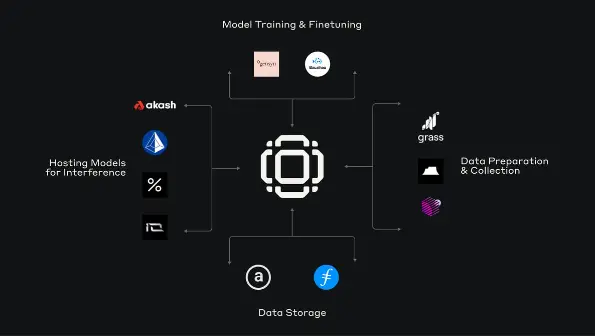
Modular AI Technology Stack
Background Introduction
Today, artificial intelligence (AI) has become the core technology of many modern products and user solutions. An increasing number of companies and enterprises are incorporating AI technology into their systems or products.
However, there are still some core issues in the current AI field, such as lack of specialization, biases, and ambiguous data privacy concerns.
Currently, mainstream AI solutions are almost entirely developed and controlled by a few large companies. Relying on these companies to solve problems essentially gives them more control over our digital lives and increases our dependency on them. They not only have access to user-submitted data but also decide how to use and process that data, even influencing the output results—in fact, they are shaping our digital world.
In this article, we will explore how to redesign the AI technology stack in a modular way through decentralization and open-source development to address these issues. We will detail the various components of the technology stack, how they work together, and how Gaia integrates these elements to achieve decentralized AI construction.
Understanding the Need for Modularity in AI Development
Today’s large companies possess vast amounts of user data, computing power, and other resources, and they are not strongly motivated to address these limitations.
Why?
Because centralization is always more beneficial for large companies. They can control the distribution of power—raising entry barriers, reducing or acquiring competitors, influencing policies, and even monetizing at will.
To break this pattern, the development concepts of decentralization and open-source are combining to build a fairer, more inclusive, and transparent alternative: Decentralized AI (DeAI).
Five Key Advantages of Decentralized AI:
- Users and organizations can control their proprietary data and sensitive information while utilizing AI capabilities.
- Developers can freely combine different models, domain knowledge, user data, and computing resources.
- Open-source components allow the community to review and improve AI solutions.
- Modularity enables AI systems to be customized and fine-tuned according to industry or specific use cases, achieving more efficient and precise results.
- Decentralization allows everyone to freely create, access, adjust, and even monetize specialized AI solutions.
As a pioneer of decentralized AI, Gaia is reimagining AI as a modular, composable technology stack that allows anyone to create, customize, and scale AI agents.
To fully leverage modularity and build efficient, personalized AI solutions, we need to deeply understand the decentralized AI technology stack.
In the next section, we will explore the various components of the decentralized AI technology stack, the concept of composability, and how Gaia drives the realization of all this.
Deconstructing the Decentralized AI Technology Stack
Decentralized AI is not just about simply replacing centralized models with open-source ones; it requires fundamentally redesigning the way AI systems are built, deployed, and managed.
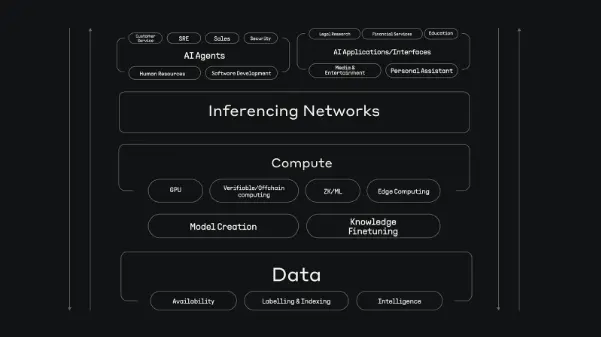
Decentralized AI Technology Architecture
The technology stack of decentralized AI consists of three foundational components:
- Technical Architecture: The core foundation of decentralized AI, covering key facilities of the computing layer, data layer, and AI model layer.
- Applications and Interfaces: The window through which developers and users interact with AI agents and tools.
- Development Orchestration and Inference: The "command center" of AI agents, responsible for coordinating the flow of information, computation, and collaboration.
Next, we will detail the various components of the decentralized AI technology stack.
Technical Architecture—The Engine of Decentralized AI
The technical architecture of decentralized AI includes four key levels that work together to provide a flexible, modular AI development framework:
Decentralized Computing Layer: This layer allocates computing tasks across the network through GPU pools, edge devices, and privacy-preserving computing protocols. Unlike traditional centralized data centers, decentralized computing dynamically distributes workloads for distributed processing.
Key Components:
GPU Pools: For training and inference of intensive models.
Edge Devices: For local data processing, reducing latency.
Verifiable Computing using ZK-SNARKs: Ensures computational accuracy while protecting privacy.
Gaia coordinates these computing resources to ensure balanced distribution of tasks across the network and executes them with verifiable accuracy.
More importantly, Gaia has partnered with Jiritsu, Jiritsu is a trustless operating system based on zkMPC (Zero-Knowledge Multi-Party Computation). Through this partnership, Gaia can build custom AI agents with verifiable computing capabilities using Jiritsu's zkMPC, and we are very excited about this.
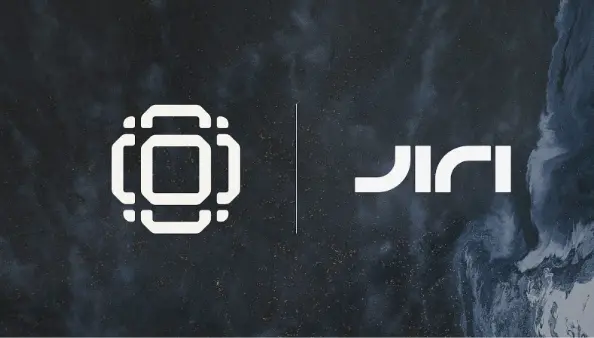
To learn more about the partnership details, please read: GaiaNet Collaborates with Jiritsu to Advance Decentralized AI Operations
Data Layer: Responsible for managing data storage, availability, and transformation in the decentralized network. This layer is crucial for high-quality data used to train and fine-tune AI models.
The data layer provides:
Distributed storage on networks like IPFS, Arweave, and EigenDA to ensure data redundancy and availability.
Community-driven data labeling, indexing, and validation mechanisms to make data more organized.
Real-time data provided by oracles to ensure data accuracy.
Gaia ensures secure and efficient access to data from decentralized sources, supporting the continuous development of AI. Recently, Gaia partnered with the user-owned data network Vana to jointly build a transparent, fair, and user-oriented AI ecosystem.
Learn more: Gaia x Vana: Partnership Announcement, or click here to listen to the Twitter Spaces discussion: Gaia x Vana: User Data Empowering AI Agents.
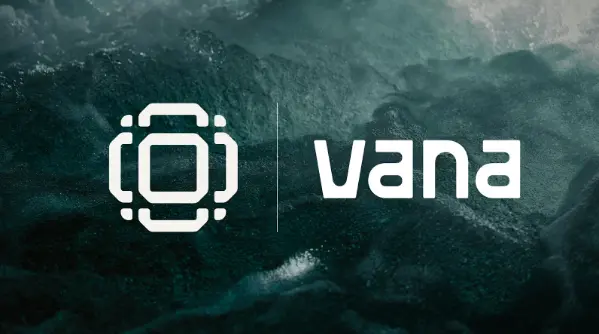
AI Model Layer: This layer is responsible for creating, training, and deploying AI models in a decentralized environment, supporting modular design that allows models to be seamlessly customized and scaled for specialization:
- Specialized language models (LLMs) and professional model optimizations for specific industries (e.g., finance, chemistry, or healthcare).
- Decentralized training frameworks that leverage distributed computing resources to create and update AI models.
- Fine-tuning tools that enable models to continuously learn and adapt from decentralized data streams to ensure accuracy and timeliness.
Inference and Deployment Layer: This layer is responsible for the real-time deployment and servicing of AI models, efficiently distributing and processing requests through inference nodes in a distributed network.
The inference and deployment layer enhances AI capabilities by:
- Providing a network of inference nodes for localized model services.
- Load balancing to optimize performance and resource utilization.
- Edge deployment options for low-latency applications.
We have just detailed the core components of decentralized AI, but how do these components work together to truly bring AI agents or solutions to "life"?
Gaia: The Orchestration Layer that Integrates Everything
Gaia is an open-source framework that ensures smooth operation and integration between different components such as data, computing resources, AI models, and applications, while providing developers with the tools and governance structures needed to build powerful and specialized AI solutions. The orchestration layer of Gaia gives "vitality" to each module, enabling different parts of the AI technology stack to work together seamlessly.
Five Core Functions of Gaia in the Decentralized AI Technology Stack
- Orchestration: Gaia coordinates the entire decentralized AI stack by managing task flows, computing resources, and communication between components. It balances node workloads, ensures optimal resource allocation, and prevents system bottlenecks.
- Inference: The inference layer executes AI models in real applications, distributing processing tasks across nodes to support tasks such as image recognition, language translation, or customer service, achieving rapid responses. Through decentralized inference, Gaia can ensure consistent performance of AI services while scaling.
- Node Management: Gaia deploys and manages nodes on edge devices and cloud infrastructure, which are the fundamental building blocks of the network. They host AI agents and run inference tasks. The distributed architecture eliminates single points of failure and scales flexibly based on demand.
The global distribution of Gaia nodes is shown in the diagram below, demonstrating the commitment to decentralization.
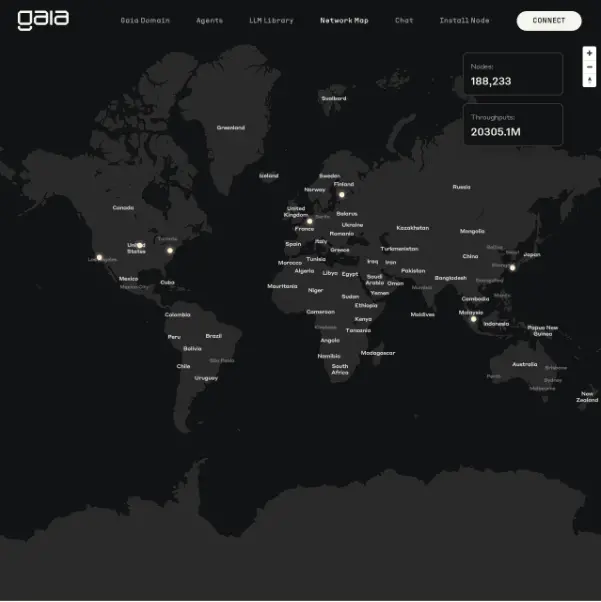
- Incentive Mechanism: The built-in token mechanism of Gaia ensures alignment of interests among stakeholders. Node operators are rewarded for providing computing resources, developers are rewarded for contributing code, and data providers are rewarded for sharing datasets. This layer of economic incentives drives sustainable growth of the network and encourages high-quality contributions.
- Governance: A governance framework based on DAO (Decentralized Autonomous Organization) enables transparent decision-making and resource management. Stakeholders can propose and vote on protocol changes, ensuring that the network's development aligns with community needs and maintains the operational integrity of the system.
All the components mentioned above are invisible to the end users. Next, we will focus on the user interface layer—applications and interfaces.
AI Applications and Interface Layer—The Intersection of AI and Users
The AI applications and interface layer serves as a bridge between decentralized AI solutions and end users and developers. Here, the underlying technology is presented, bringing AI-driven tools and agents into various industries and application scenarios, generating real value.
Examples of applications and interface layer include:
- Customer Service Agents: Autonomous AI agents that automate the handling of customer inquiries.
- Financial Analysis Tools: Professional AI agents used to analyze financial data, simulate market conditions in real-time, and provide trading and analytical insights.
- Software Development Assistants: AI programming assistants that help developers write, debug, and optimize code.
To make it easier for developers and users to utilize decentralized AI (DeAI) and Gaia agents, Gaia offers two main solutions.
- Gaia Domain
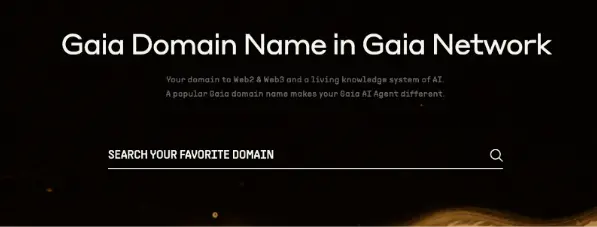
Gaia Domain provides critical visibility for end applications, ensuring that decentralized AI services are discoverable and reliable. Technically, Gaia Domain acts as a trust cluster, similar to a collection of nodes, allowing users to confidently choose and use compliant AI services.
Key Advantages of Gaia Domain:
- Quality Assurance: Domain operators validate nodes to ensure they meet specific performance and reliability standards.
- Load Balancing: Requests are distributed among nodes within the domain, optimizing service performance.
- Specialized Services: Users can easily find AI agents focused on specific industries or applications to meet diverse professional needs.
- Economic Incentive Alignment: Domain operators are accountable to users; if nodes fail to provide reliable or accurate results, operators will lose trust and economic returns.
- Trust Layer: Domain operators enhance their reputation by maintaining the service quality of nodes within their domain.
In simple terms, Gaia Domain provides users with the necessary transparency to understand and trust the AI services they use.
- Gaia DeAI Market
The Gaia Market is a marketplace structure for trading artificial intelligence assets, built from personalized knowledge bases and AI components. It can be seen as a "YouTube for knowledge and skills," allowing experts to monetize their expertise and AI capabilities on this platform.
Typical components of transactions include:
- Fine-tuned AI Models
- Knowledge Bases and Datasets
- Function Call Plugins
- Custom Prompts and Workflows
Key Values of the Gaia Market:
- Support for AI Developers: Access to high-quality off-the-shelf components makes building agents more efficient.
- Incentive Mechanism: Developers and contributors are rewarded with Gaia tokens, helping creators monetize their intellectual property.
- Enterprise Applications: Enterprises and institutions can build dedicated AI agents without large-scale infrastructure investments.
Gaia Simplifies the Construction of Decentralized AI
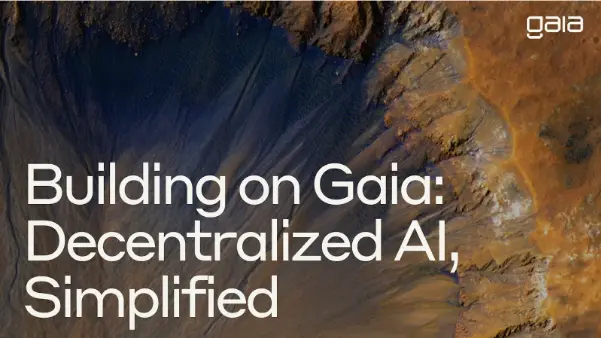
Building on Gaia
Building on Gaia represents a shift in the way AI is developed—from a model dominated by a few tech giants to an AI ecosystem where everyone can participate and benefit. This democratization of AI development will foster more purpose-specific solutions, and specialized AI agents and solutions contributed by domain experts can receive fair returns.
Gaia is committed to creating the infrastructure that supports these possibilities, making decentralized AI more accessible and practical.
Whether you are a developer looking to create custom AI agents, a business seeking secure AI solutions, or an expert wanting to monetize knowledge, Gaia provides the necessary tools and infrastructure.
Resource Links to Help You Get Started Quickly:
- Gaia User Guide: https://docs.gaianet.ai/category/gaianet-user-guide
- Chat UI: https://knowledge2.gaianet.network/chatbot-ui/index.html
- Node Installation: https://github.com/GaiaNet-AI/gaianet-node
Additional Resources for Installing Gaia Nodes:
- https://drive.google.com/file/d/1j0rndzozYWX4y5ftY1XVgSDNXxvhgXcw/view
- https://youtu.be/b2qlaKqyKoE?si=WZdEU-mvJZayW03I
Demo Videos:
免责声明:本文章仅代表作者个人观点,不代表本平台的立场和观点。本文章仅供信息分享,不构成对任何人的任何投资建议。用户与作者之间的任何争议,与本平台无关。如网页中刊载的文章或图片涉及侵权,请提供相关的权利证明和身份证明发送邮件到support@aicoin.com,本平台相关工作人员将会进行核查。




